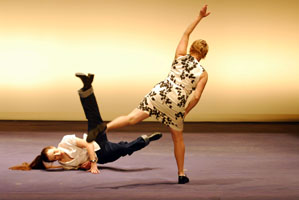
Jack Anderson
Monk and Transience
 |
| Ellen Fisher, Ching Gonzalez. Photo by Stephanie Berger |
Meredith Monk: "impermanence"
Next Wave Festival
BAM Harvey Theater
651 Fulton Street, Fort Greene, Brooklyn
Closed Nov. 5, 2006
Reviewed by Jack Anderson, Nov. 4, 2006
A capital letter wasn't necessary. Meredith Monk calls her new production "impermanence," and she's right in making her title lower-case.
Often when writers or choreographers dispense with capitals in their titles, the results seem affected. But titling this work "Impermanence" would be all wrong. That big letter "I" suddenly lifts the word into the realm of Eternal Verities along with such formidable abstractions as Truth and Time. Monk, who as usual was responsible for her piece's conception, direction, and music, certainly had truth and time on her mind. But what she emphasizes is transience itself, the sheer flux of existence, and so we have "impermanence," a lower-case word that doesn't stand grandly forth, but seems part of some sort of context.
Monk's immediate inspirations are the death of her long-time partner and her experiences working in a London hospice. The resultant two-act creation for an ensemble of singers, dancers, and instrumentalists is plotless, without specific characters or narrative. And yet it is theatrically rich and poignant.
 |
| Meredith Monk, Ellen Fisher. Photo by Stephanie Berger. |
The first things that command attention are videos of faces, male and female, young and old, each face dissolving into the next. Most faces try to remain immobile. But a few eye-blinks reveal that these people are alive. Monk sits at a piano and sings a song based upon phrases introduced with the word "last," as in "last chance," "last dance," "last minute," "last laugh." Some of the words occasionally dissolve into pure vocal sounds, as if to imply that words themselves are impermanent.
Other performers enter in costumes by Yoshio Yabara that range in formality from jeans to a ball gown. A seated man and woman fuss with their clothes, gesture toward the floor as if searching for something lost, and then recite such sentences as "She liked her eggs over easy" and "He always carried a silver dollar in his pocket," the sort of reminiscences friends of a deceased might trade at a memorial service. Later, there are moments when people appear to be lowering other people into graves.
This melancholy mood is briefly broken when, as observers watch from the sidelines, individuals caper into a lighted space to prance through an eccentric square dance. But their exertions finally exhaust them: jollity and melancholy can be equally fleeting. Nothing lasts, everything forms and dissolves, yet can also take new shapes, a message affirmed when videos of swirling and seemingly indeterminate forms cohere into such objects as wood, hair, and plants.
In the second act, everyone wears costumes similar to those of the previous act, but now in shades of ghostly gray. Going from the overall quiet of the first act to the bustle of a long intermission and then back to theatrical introspection required considerable mental effort. However, once the adjustment was made, it was possible to admire how "impermanence" flowed along.
More video portraits are projected. But whereas the first-act faces looked very much of our time, these people are in costumes from past eras, Monk thereby acknowledging both aging and death. Impressions of transience are also conveyed in other ways, some solemn, some whimsical. There is a processional with swaying and kicking steps. In one scene, after what sounds like a train whistle, an express of a sort roars in: a man on roller skates. And shadows flicker across the back wall
 |
| Meredith Monk, Theo Bleckmann, Ellen Fisher, Katie Geissinger, Ching Gonzalez, Bohdan Hilash, John Hollenbeck, Allison Sniffin. Photo by Stephanie Berger |
A litany is based on phrases introduced by the word "between": for instance, "between the clouds and the night," "between the window and the street," "between the skull and the brain." As phrase follows phrase, people roll across the floor into darkness, and the act concludes with quiet chimes.
Monk's "impermanence" brings to mind some words of Isaac Watts, the 18th-century British hymn writer who once declared, "The busy tribes of flesh and blood, / With all their lives and cares, / Are carried downwards by the flood / And lost in following years. / Time, like an ever-rolling stream, / Bears all its sons away; / They fly forgotten, as a dream / Dies at the opening day."
Monk has contributed her own eloquent meditative theatrical
stanzas to this hymn.
| museums | NYTW mail | recordings | coupons | publications | classified |
